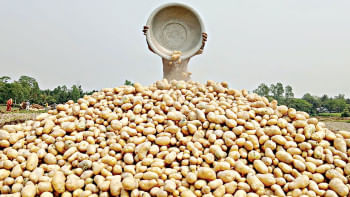Grounded in the AI race

In Rajbari, the shuttered doors of Salina Akter's jute workshop tell the story of how artificial intelligence is reshaping global trade and leaving Bangladesh's small businesses stranded. For five years, she stitched eco-friendly bags for European buyers. Then the orders stopped. Her clients now demanded AI-optimised production schedules, predictive inventory systems and delivery timelines that only automated supply chains can provide. Salina's modest factory could not keep pace.
This is not an isolated case. SMEs employ 80 percent of the non-farm workforce and generate roughly a quarter of GDP. Yet while other developing economies are rolling out targeted AI adoption programmes for small businesses, our policy response remains trapped in strategy papers and consultation rooms. Even flagship documents such as the Task Force Report 2025 and other national policy blueprints barely acknowledge the AI shockwave hitting these enterprises. The threat is real. Competitors are building SME-focused AI pipelines, while we continue to debate paper-based loan forms as if it were 1990.
Consider the ingenuity of Dholaikhal's light engineering workshops. During the darkest days of Covid-19, I connected my own network at MIT, where ventilator innovation had been open-sourced for global adaptation, with Abdul Kader and a group of machinists and fabricators in Dholaikhal. Together, we reverse-engineered the MIT process and built a fully functional mechanical ventilator prototype. The core mechanical design was ready, but the project stalled because we could not integrate an electrical control system that met regulatory standards. There was no government-backed technical assistance, prototyping support or fast-track testing facility to bridge that gap. What could have been a homegrown life-saving device became just another workshop prototype gathering dust. If we could not scale a ventilator in a health emergency, how will SMEs scale AI adoption in the midst of a trade war?
Other nations are already turning ambition into action. India's Drone Didi trains rural women to operate agricultural drones, raising yields by 30 percent and cutting pesticide use in half. Vietnam earmarks 1 percent of GDP for SME tech upgrades, delivering plug-and-play AI tools with minimal paperwork. Kenya's Ajira Digital connects SMEs to global AI-enabled service markets, backed by microfinance.
Bangladesh's AI Policy does mention investment through government funding, tax incentives and public–private partnerships. Yet the criteria are tied to broad categories such as R&D, infrastructure and education. There is no ring-fenced allocation for SMEs, nor a mandate for ministries to embed AI adoption targets into sectoral budgets. The ambition to nurture a skilled workforce is welcome, but the scale is modest. Training tens of thousands will not suffice when millions will need reskilling.
Without targeted mechanisms, AI readiness will concentrate in large firms and urban start-ups, leaving rural and manufacturing SMEs locked out. The risk is not abstract. The Dholaikhal ventilator showed how quickly ingenuity can rise to meet a crisis, and how easily it can be stranded without systemic support.
Bangladesh's economic rise owes much to SMEs. To sustain that rise in an AI-driven world, policymakers must turn the promises of the AI Policy into concrete SME programmes: a dedicated adoption fund worth 1 percent of GDP, subsidies for basic automation tools in manufacturing and agriculture, vocational training in machine vision and robotics, and tax holidays for SMEs that invest in AI.
Right now, India's Drone Didis and Vietnam's tech-enabled SMEs are already airborne. Bangladesh's entrepreneurs remain on the tarmac, engines idling, waiting for clearance that never comes. The race has begun. We cannot afford to stay grounded while others take flight.
The writer is a former research fellow at MIT D-Lab

 For all latest news, follow The Daily Star's Google News channel.
For all latest news, follow The Daily Star's Google News channel. 



Comments